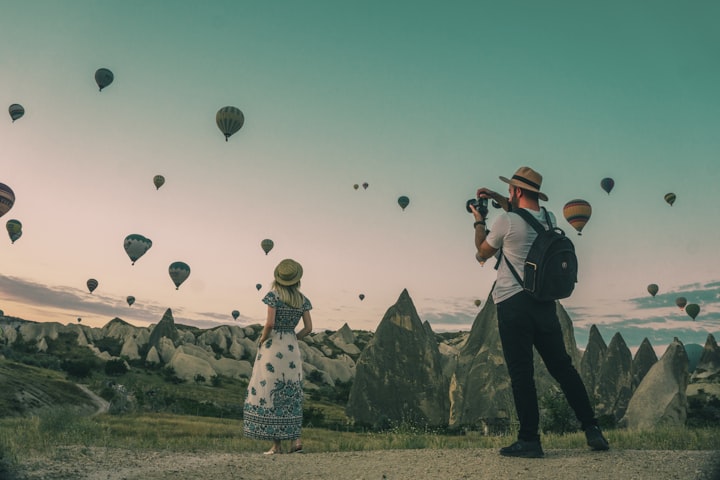FINE ART PHOTOGRAPHY
Exploring the world of fine art photography

Introduction:
Fine art photography is a captivating form of visual expression that combines technical skill, creativity, and a unique perspective. It goes beyond mere documentation, transcending into the realm of art, where photographs are imbued with personal interpretation, emotion, and a touch of the artist's vision. In this write-up, we delve into the realm of fine art photography, exploring its characteristics, techniques, and the profound impact it has on the artistic landscape.
1. The Essence of Fine Art Photography:
Fine art photography is driven by the artist's desire to evoke emotions, provoke thought, and convey a message or concept through visual storytelling. It goes beyond the boundaries of traditional photography, embracing experimentation, abstraction, and
conceptualization. The focus is not solely on the subject matter but also on the artist's interpretation and vision, resulting in visually striking and thought-provoking images.
2. Creative Vision and Conceptualization:
Fine art photography begins with an artist's unique vision or concept. It involves a deliberate process of envisioning and planning, where the artist carefully crafts each element within the frame to evoke a specific mood or convey a particular idea. This may involve the use of symbolism, metaphor, composition, lighting, and other artistic techniques to create a visual narrative that engages the viewer on multiple levels.
3. Exploring Techniques and Styles:
Fine art photography encompasses a wide range of techniques and styles, allowing artists to express their creativity in diverse ways. It can include black and white photography, long exposures, multiple exposures, abstract compositions, unconventional perspectives, and experimental post-processing techniques. The use of these techniques adds depth, texture, and a sense of artistic flair to the images, enhancing their visual impact.
4. Embracing Emotion and Expression:
Fine art photography often aims to evoke emotions and create a visceral connection with the viewer. The artist may capture moments of beauty, contemplation, solitude, joy, or even evoke feelings of melancholy, mystery, or nostalgia. By harnessing the power of light, composition, and subject matter, the photographer can create a visual language that transcends the limitations of words, enabling the viewer to experience a profound emotional response.
5. Print and Presentation:
The final presentation of fine art photography is a crucial aspect of the medium. Many fine art photographers believe that the ultimate expression of their work lies in the physical print.
Careful attention is given to selecting the right paper, texture, and print size to complement the artistic intent. The choice of framing, matting, and display also plays a significant role in enhancing the overall aesthetic experience for the viewer.
6. Impact and Significance:
Fine art photography holds a unique position in the art world, offering a powerful medium for self-expression and commentary on society, culture, and the human condition. It challenges conventional perspectives, sparks conversations, and invites viewers to engage with the artwork on an intellectual and emotional level. It has the ability to inspire, provoke thought, and create a lasting impact that transcends time.
Conclusion:
Fine art photography is a realm where technical proficiency, creativity, and artistic vision intersect. It opens up a world of endless possibilities, allowing artists to express themselves, explore emotions, and challenge traditional norms. Through deliberate conceptualization, experimentation with techniques, and thoughtful presentation, fine art photography enriches our visual culture and invites us to see the world through a different lens. It serves as a reminder of the boundless potential of photography as an art form and its capacity to evoke profound emotions and inspire meaningful connections. Fine art photography stands as a testament to the boundless creativity and expressive power of the medium. It breaks away from the constraints of traditional photography, embracing imagination, experimentation, and personal interpretation. Through deliberate conceptualization, technical mastery, and the infusion of emotion, fine art photographers create images that resonate deeply with viewers.
Fine art photography challenges us to see beyond the surface, to engage with the artist's vision, and to contemplate the underlying meanings and narratives within each frame. It encourages us to explore our own emotions, thoughts, and perceptions, and invites us into a dialogue with the artwork.
The significance of fine art photography extends beyond aesthetic appreciation. It serves as a catalyst for introspection, offering a visual language that can provoke discussion, challenge societal norms, and shed light on important issues. It has the power to evoke empathy, empathy, and inspire change, making it an influential force within the broader artistic landscape.
As viewers, we have the privilege of experiencing the artist's journey, witnessing their unique perspective and creative expression. Fine art photography encourages us to slow down, to immerse ourselves in the visual stories captured within each frame, and to appreciate the intricacies and nuances that lie within the image.
Ultimately, fine art photography serves as a reminder of the immense potential of photography as an art form. It encourages us to explore our own creative instincts, to push boundaries, and to embrace photography not just as a means of capturing reality, but as a powerful medium for personal expression and artistic exploration.
So let us celebrate the world of fine art photography, embrace its diversity, and immerse ourselves in the transformative power of the images that grace our galleries, exhibitions, and art collections.





Comments
There are no comments for this story
Be the first to respond and start the conversation.